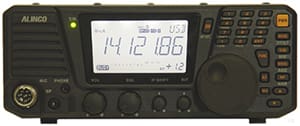Serious cruisers have depended on amateur ham single sideband radio (SSB) since the early 1960s. Imagine sailing in the mid-Pacific and talking to a guy drinking beer in a cottage in England, or to a senior government official in an African republic. This is the power of ham radio. Your primary duty as a sailor, though, is to maintain contact with other sailing vessels in your group or region and to share crucial information regarding weather, sailing conditions and the most up-to-date information regarding checking-in procedures at various ports.
For many cruisers, upper sideband marine SSB on 40 meters provides sufficient communication capacity beyond the VHF. Marine SSB is enabled through a dedicated marine band HF (high frequency) radio transceiver, such as the 150-watt IC-M802 from Icom. However, many skippers use a standard ham radio rig to receive and transmit on marine SSB channels. Some radios, such as the legacy Kenwood TS-50, need to be modified to use upper sideband on 40 meters.
The FCC forbids ham sets from transmitting on marine SSB frequencies, but this is standard procedure among cruising hams. The exception to this law is when there is danger to human life. Information regarding severe weather conditions, sea state, obstructions and piracy is meant to save human lives, and these are issues you are discussing routinely. If you happen to throw in a recipe for tuna casserole during one of your contacts about a gale near Socotra Island while crossing the Arabian Sea, believe me: No one cares.
Ham and marine SSB radio operation requires FCC licensure, although there are significant differences in what the two licenses cover and the process for securing the licenses. Applying for an FCC ship radio license is a simple affair requiring you to fill out a form and pay a one-time fee of $60. An FCC amateur radio (ham) license permitting communication on many radio frequency bands, including 40 meters, requires you to pass the General Class amateur radio test. You must understand basic electronics, radio reception and transmission, basic antenna propagation theory and the laws governing amateur radio transmission.
If you are a serious cruiser, you owe it to yourself to pass the Technician and General ham tests, both required for your General Class license. If you enjoy math and want to study additional antenna theory, you can prepare for the Extra Class license exam. Most of the chatter on ham radio, though, is on the General Class portions of the ham frequency bands.
With only a vessel station license, your marine SSB is limited to exactly that, marine SSB. No licensed ham operator in the world will respond to an unlicensed ham radio operator (easily verified online), except in a life-threatening emergency. With a General Class ham license, you have access to more frequency bands, allowing greater flexibility in how you communicate.
Besides being able to chat with other cruisers and ham operators on SSB, your ham radio can be linked to your laptop computer via a Pactor modem to enable communication through SailMail. For a small annual fee, cruisers who want worldwide email access can join this nonprofit organization in order to send and receive email from any point on the planet.
There is no further charge to send or receive an unlimited number of emails through SailMail via SSB. SailMail provides an updated list of SSB frequencies in their network so you are always within range of a SailMail station. With the service now offering access to Inmarsat or Iridium satellites, ham radio continues to provide the most robust communications option for cruisers.
Circumnavigator-author Bill Morris is the author of Sun, Wind, & Water: The Essential Guide to the Energy-Efficient Cruising Boat and is a frequent contributor to Ocean Navigator.

